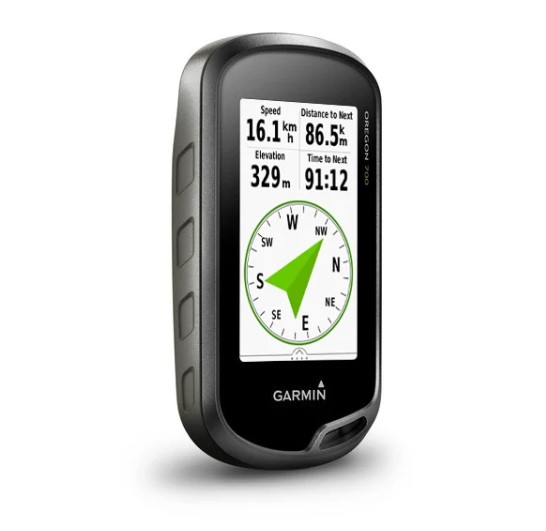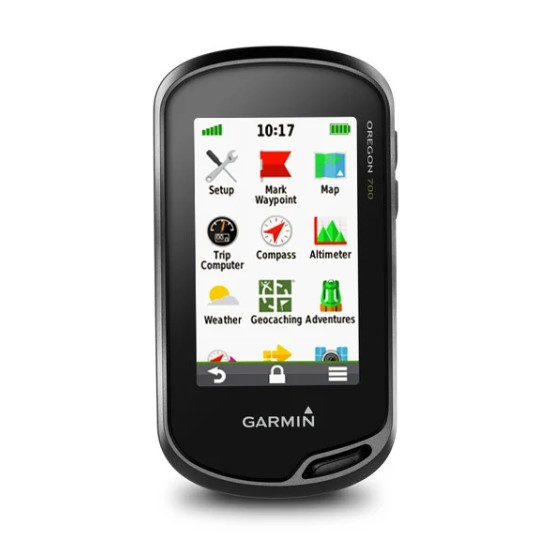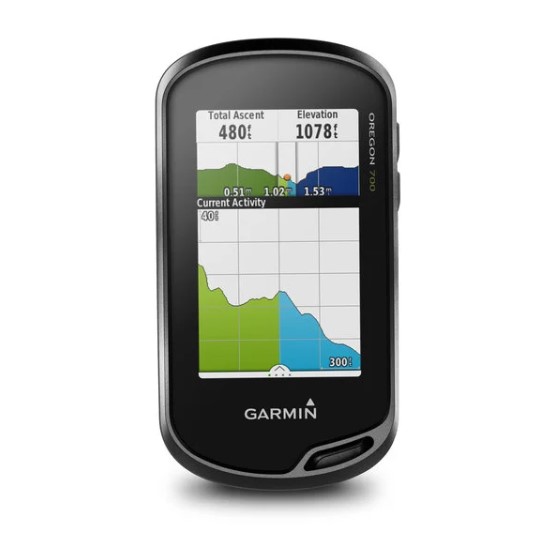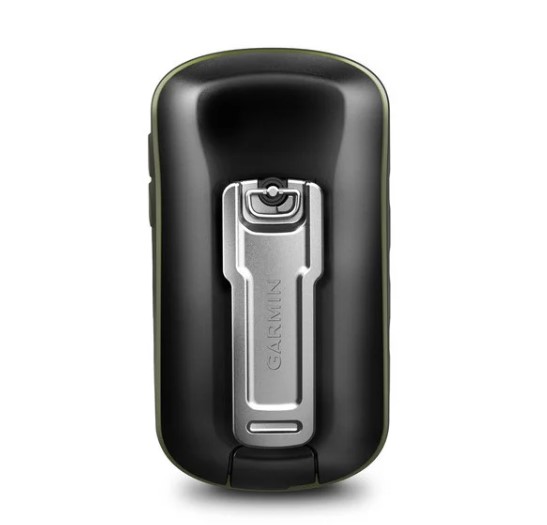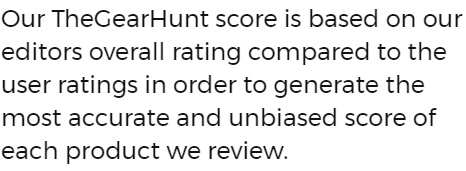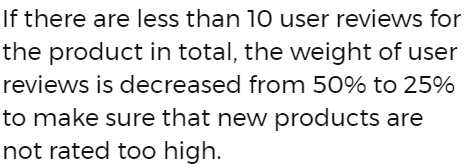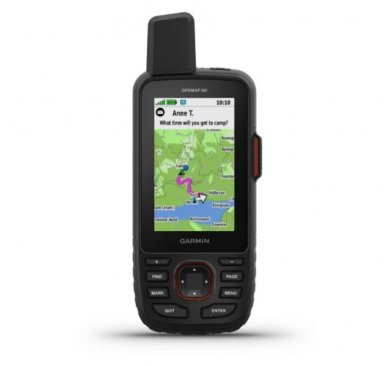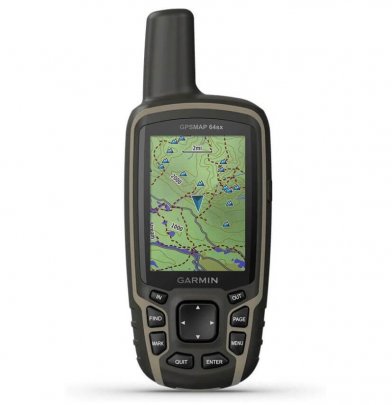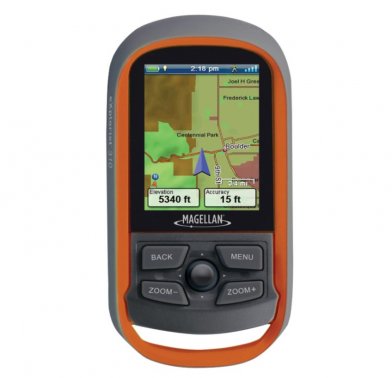Garmin Oregon 700
Editor’s Conclusion
Meet a handheld GPS device masquerading as a smartphone in the form of the Garmin Oregon 700. With dual-orientation facilities, a touchscreen, and fancy features, you'll get a great handheld suitable for many activities.
But this isn't a smartphone, and that's obvious with the wide-ranging navigation included via powerful antennas. Garmin also ensures you get a built-in 3-axis compass with an accelerometer and barometric altimeter sensors, which you wouldn't get with a smartphone. This allows you to measure your elevation and prevent getting caught in dangerous storms.
Updating the software quickly, checking the weather, and sharing your location is easy through WiFi or your smartphone, which I think most people will love. Sturdy and reliable, but this isn't all the Oregon 700 can do.
But this isn't a smartphone, and that's obvious with the wide-ranging navigation included via powerful antennas. Garmin also ensures you get a built-in 3-axis compass with an accelerometer and barometric altimeter sensors, which you wouldn't get with a smartphone. This allows you to measure your elevation and prevent getting caught in dangerous storms.
Updating the software quickly, checking the weather, and sharing your location is easy through WiFi or your smartphone, which I think most people will love. Sturdy and reliable, but this isn't all the Oregon 700 can do.
Editor's Pros & Cons
Pros
Pros
Good reception
3D Digital Compass
Touchscreen Display
Barometric Altimeter
Smartphone like features
Wireless communication
Plenty of waypoint storage
Cons
Expensive
Battery life could be longer
Screen not as good as smartphone
More waypoint storage and features than needed
Key Features
Snapshot of Key Features
Memory: 1.7 GB
Live weather reports
Battery life: Max 16 hours
Weight: 209.8g with batteries
2 AA batteries (not included)
Networks: GPS & GLONASS
Display size 3.8 x 6.3 cm/3" diag (7.6 cm)
Connectivity: WiFi, Bluetooth, and ANT+
Waterproofing: IPX7 (can be submerged briefly up to 1m)
3" sunlight-readable touchscreen display + dual orientation
Built-in 3-axis compass with accelerometer & barometric altimeter
Basic & Advanced Features
Even the basic features of the Oregon 700 make it already better than the handheld navigation competition. Because of the touch screen display, GPS, the GLONASS satellite networks, and an improved antenna, the Oregon 700 works accurately and efficiently.
The Oregon 700 is surprisingly intuitive, and the maps are easy to read. Setting the maps up is also accessible by pre-setting the activity profiles, which shows a map of your location upon switching on. Then, all you need to do is swipe left or right for different. Unfortunately, the TOPO Active maps that Garmin usually provides in other Garmin products are missing here.
There is undoubtedly plenty of features in the Oregon 700 to make life easy for its users, such as the new compatibility with the Garmin Connect IQ platform. This means users can customize the 700 with apps, widgets, and data fields, which is helpful for cycling or hiking.
You'll also get ABC functionality, referring to the built-in altimeter, barometer, and compass. Adding these features is essential as the altimeter lets you know your elevations (how high you are), enabling you to monitor your ascents and descents. Combine this with the barometer, which monitors air pressure, and you can better predict weather changes. Knowing if there will be any drastic weather changes allows you to avoid getting into dangerous, potentially fatal weather traps.
The compass feature is excellent, and as a 3-axis compass, you get accurate navigation whether you're stationary or moving. Geocaching is another outstanding feature of the Oregon 700. Using the geocaching function is easy; search the Geocaching app from the home screen and select the search function.
Use
Plenty of features makes this Garmin handheld device suited to a wide range of activities. Location tracking, messaging service, no-nonsense navigation, weather forecasting and more means you can use the 700 for hiking, mountaineering, mountain biking, cycle touring or geocaching. The Oregon 700 deals with most adventures superbly, whether traveling over water, remote terrains, or higher altitudes.
Connectivity
Using the GPS and the GLONASS satellite systems means connecting to satellites is easy and accurate due to the amplified antenna, which locks your position quicker. In addition, with WiFi and smartphone connectivity, you can receive messages on the screen of your handheld device, update the device, connect to apps, and use all the extra features like live tracking data.
Accuracy
Picking up satellites fast, the Oregon 700 knows how to navigate and track your location. There is plenty of space for maps, and with the use of GPS, GLONASS, WAAS, and Egnos satellite systems, the routing is highly accurate and reliable.
Enjoying some fresh mountain air is easier with plenty of extra features. These features include an altimeter to allow accurate elevation data, a barometer for better weather predictions, and essential navigation features. However, Garmin could potentially update the track navigation, which could be considered outdated compared to other devices that provide alerts when you get off course. However, the navigation does recalculate quickly when going off track.
Power Source
Why buy a device that looks and works like a smartphone when you could buy a smartphone? Well, that would probably drain your smartphone battery, and you don't want to be caught out with no navigation mid-hike. So, purchasing a handheld device with long battery life is essential. In contrast, the Oregon 700 holds its own with battery life as good as Oregon says it is. Just remember to switch off the Bluetooth and use the "power save" mode, and you'll get 16 hours of battery.
Durability
With an IPX7 level of waterproofing, the 700 can cope with brief submersions up to 1meters, so you can relax knowing that rain and snow won't break this device. You are likely to get caught in bad weather, so this is a must for us.
Display
Although the pixels aren't as high as a modern smartphone, this Oregon screen vastly improves the GPS devices' joystick. With three inches color touchscreen that is bright enough and easy to read even in direct sunlight, your journey is more leisurely. In addition, this screen makes planning your route, reading the landscape, and scrolling through the menu so much easier and quicker than joystick navigation.
The tilting screen and dual-orientation function also make it easier to move the screen around while on the move, meaning more straightforward and better tracking of your surroundings.
Ease of Use
The Garmin Oregon 700 is more user-friendly with an improved interface and a few other improvements than older models. It's more intuitive for use on the move, and it is easy to set up for basic use. However, if you want to use the advanced features, you will want to read the instruction manual. As some users feel the instructions are basic, you may need to look for some great instructional videos we found on YouTube.
Although the touchscreen has improved and works well, it's not as great as a smartphone, and it can take a few goes to get right. But it's still perfectly usable. The touchscreen can also be hard to use in poor weather but adding a power button as a menu is great for occasions when weather or gloves make it hard to use.
Price
Coming in at about $400, the cost of this GPS handheld may sting a little. But this is one of Garmin's more affordable navigation devices and is excellent value for money. With a touchscreen display, convenient wireless connectivity, high speeds, and accurate navigation, the Oregon 700 offers fantastic value for money. So, if you're after a Global Positioning System with touchscreen abilities, the Oregon 700 is a first-class choice for value for money.
Bottom Line
Known for its superb user-friendly features and accurate navigation, the 700 from the Garmin Oregon series is ideally suited to a wide range of activities. Loaded with plenty of helpful features, the Oregon 700 is probably one of Garmin's best value and cheapest of the Oregon series. With a dual-orientation touchscreen and a long list of features, this smartphone-like device offers everything you need to navigate the trail as you customize profiles for a variety of activities.
Memory: 1.7 GB
Live weather reports
Battery life: Max 16 hours
Weight: 209.8g with batteries
2 AA batteries (not included)
Networks: GPS & GLONASS
Display size 3.8 x 6.3 cm/3" diag (7.6 cm)
Connectivity: WiFi, Bluetooth, and ANT+
Waterproofing: IPX7 (can be submerged briefly up to 1m)
3" sunlight-readable touchscreen display + dual orientation
Built-in 3-axis compass with accelerometer & barometric altimeter
Basic & Advanced Features
Even the basic features of the Oregon 700 make it already better than the handheld navigation competition. Because of the touch screen display, GPS, the GLONASS satellite networks, and an improved antenna, the Oregon 700 works accurately and efficiently.
The Oregon 700 is surprisingly intuitive, and the maps are easy to read. Setting the maps up is also accessible by pre-setting the activity profiles, which shows a map of your location upon switching on. Then, all you need to do is swipe left or right for different. Unfortunately, the TOPO Active maps that Garmin usually provides in other Garmin products are missing here.
There is undoubtedly plenty of features in the Oregon 700 to make life easy for its users, such as the new compatibility with the Garmin Connect IQ platform. This means users can customize the 700 with apps, widgets, and data fields, which is helpful for cycling or hiking.
You'll also get ABC functionality, referring to the built-in altimeter, barometer, and compass. Adding these features is essential as the altimeter lets you know your elevations (how high you are), enabling you to monitor your ascents and descents. Combine this with the barometer, which monitors air pressure, and you can better predict weather changes. Knowing if there will be any drastic weather changes allows you to avoid getting into dangerous, potentially fatal weather traps.
The compass feature is excellent, and as a 3-axis compass, you get accurate navigation whether you're stationary or moving. Geocaching is another outstanding feature of the Oregon 700. Using the geocaching function is easy; search the Geocaching app from the home screen and select the search function.
Use
Plenty of features makes this Garmin handheld device suited to a wide range of activities. Location tracking, messaging service, no-nonsense navigation, weather forecasting and more means you can use the 700 for hiking, mountaineering, mountain biking, cycle touring or geocaching. The Oregon 700 deals with most adventures superbly, whether traveling over water, remote terrains, or higher altitudes.
Connectivity
Using the GPS and the GLONASS satellite systems means connecting to satellites is easy and accurate due to the amplified antenna, which locks your position quicker. In addition, with WiFi and smartphone connectivity, you can receive messages on the screen of your handheld device, update the device, connect to apps, and use all the extra features like live tracking data.
Accuracy
Picking up satellites fast, the Oregon 700 knows how to navigate and track your location. There is plenty of space for maps, and with the use of GPS, GLONASS, WAAS, and Egnos satellite systems, the routing is highly accurate and reliable.
Enjoying some fresh mountain air is easier with plenty of extra features. These features include an altimeter to allow accurate elevation data, a barometer for better weather predictions, and essential navigation features. However, Garmin could potentially update the track navigation, which could be considered outdated compared to other devices that provide alerts when you get off course. However, the navigation does recalculate quickly when going off track.
Power Source
Why buy a device that looks and works like a smartphone when you could buy a smartphone? Well, that would probably drain your smartphone battery, and you don't want to be caught out with no navigation mid-hike. So, purchasing a handheld device with long battery life is essential. In contrast, the Oregon 700 holds its own with battery life as good as Oregon says it is. Just remember to switch off the Bluetooth and use the "power save" mode, and you'll get 16 hours of battery.
Durability
With an IPX7 level of waterproofing, the 700 can cope with brief submersions up to 1meters, so you can relax knowing that rain and snow won't break this device. You are likely to get caught in bad weather, so this is a must for us.
Display
Although the pixels aren't as high as a modern smartphone, this Oregon screen vastly improves the GPS devices' joystick. With three inches color touchscreen that is bright enough and easy to read even in direct sunlight, your journey is more leisurely. In addition, this screen makes planning your route, reading the landscape, and scrolling through the menu so much easier and quicker than joystick navigation.
The tilting screen and dual-orientation function also make it easier to move the screen around while on the move, meaning more straightforward and better tracking of your surroundings.
Ease of Use
The Garmin Oregon 700 is more user-friendly with an improved interface and a few other improvements than older models. It's more intuitive for use on the move, and it is easy to set up for basic use. However, if you want to use the advanced features, you will want to read the instruction manual. As some users feel the instructions are basic, you may need to look for some great instructional videos we found on YouTube.
Although the touchscreen has improved and works well, it's not as great as a smartphone, and it can take a few goes to get right. But it's still perfectly usable. The touchscreen can also be hard to use in poor weather but adding a power button as a menu is great for occasions when weather or gloves make it hard to use.
Price
Coming in at about $400, the cost of this GPS handheld may sting a little. But this is one of Garmin's more affordable navigation devices and is excellent value for money. With a touchscreen display, convenient wireless connectivity, high speeds, and accurate navigation, the Oregon 700 offers fantastic value for money. So, if you're after a Global Positioning System with touchscreen abilities, the Oregon 700 is a first-class choice for value for money.
Bottom Line
Known for its superb user-friendly features and accurate navigation, the 700 from the Garmin Oregon series is ideally suited to a wide range of activities. Loaded with plenty of helpful features, the Oregon 700 is probably one of Garmin's best value and cheapest of the Oregon series. With a dual-orientation touchscreen and a long list of features, this smartphone-like device offers everything you need to navigate the trail as you customize profiles for a variety of activities.






